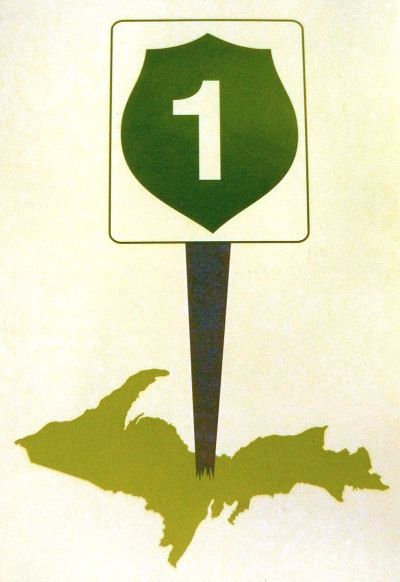| Back to |
|
|
| MSUE Resource Library | ||
| Newspaper Article Index | ||
| Forest Information Main Page | ||
| MSAF Home Page |

MSAF Auto Tour
Article #169, April 2011
By Bill Cook
You may have wondered about white and green numbered signs along the highways of the Upper Peninsula. They indicate particular forest types.
The Michigan Society of American Foresters (MSAF) has prepared an informational brochure that describes 12 distinct forest types, or forest conditions. The brochures are sometimes available at certain Michigan visitor centers or they can be obtained by writing the MSAF at 6005 J Road, Escanaba, 49829.
The information is also posted on the MSAF website at [http://michigansaf.org] under the “SAF Tours” tab.
The highlighted forest types are; 1) aspen, 2) white birch, 3) red pine, 4) white pine, 5) jack pine, 6) northern hardwoods, 7) hemlock, 8) spruce-fir, 9) cedar, 10) grass openings, 11) role of fire, and 12) old growth.
The brochure also speaks about several topics.
Forest industry is key element in maintaining healthy forests and vibrant economies. It is Michigan’s third largest manufacturing sector. There are about 200 mills and secondary manufacturers in the U.P., and many more logging and trucking contractors. And yet many more families, employees, and supporting businesses.
Forest protection remains a high priority. Wildfire, insects, and diseases present both challenges and potential benefits. Invasive exotics are a special problem and have negatively affected elms, oaks, beech, butternut, white pine, ashes, and others. Exotics can diminish habitat quality and reduce biodiversity.
Forest wildlife are one of the top interests among most forest owners and users. Nearly 600 vertebrate species have been identified in Michigan. Most of them use forest habitat for at least part of their life cycle. Habitat management, especially for game species, is one of the principal considerations in many forest management plans and practices.
Forested wetlands provide some of the most interesting and ecologically important vegetation types in Michigan. Some are dominated by broad-leaved trees, some by conifers (especially cedar), and some that are mixed. These forests are particularly common in the eastern U.P.
Forest-based recreation is a large enterprise. Activities are numerous and occasionally conflicting. Snowmobiling, hunting, camping, and wildlife observation are among the more popular endeavors. Forests draw millions from both within Michigan and outside the state.
The Tree Farm System has many thousands of acres enrolled in Michigan and is a symbol of quality forest management for a variety of forest owner goals. These forest lands are now part of a forest certification system, which allows harvested products to be more easily sold to many Michigan mills.
The Society of American Foresters is the national scientific and educational organization that represents the forestry profession in the USA. The mission is to advance the science, education, technology, and practice of forestry; and to continue the health and use of our essential forest ecosystems. The auto tour is one way in which the Michigan SAF hopes to raise awareness of Michigan’s forest diversity and use.

Trailer
Bill Cook is an MSU
Extension forester providing educational programming for the Upper Peninsula.
His office is located at the MSU Forest Biomass Innovation Center near
Escanaba. The Center is the headquarters for three MSU Forestry properties in
the U.P., with a combined area of about 8,000 acres. He can be reached at cookwi@msu.edu
or 906-786-1575.
Prepared
by Bill Cook, Forester/Biologist, Michigan State University Extension, 6005
J Road, Escanaba, MI 49829
906-786-1575 (voice), 906-786-9370 (fax), e-mail: cookwi@msu.edu
Use
/ reprinting
of these articles is encouraged. Please notify Bill Cook.
By-line should read "Bill Cook, MSU Extension" Please use the article
trailer whenever possible.
Michigan State University is an affirmative action equal opportunity institution. The U.S. Department of Agriculture prohibits discrimination on the basis of race, color, national origin, gender, religion, age, disability, political beliefs, sexual orientation, and marital status or family status. (Not all prohibited bases apply to all programs.)

This website is maintained by Bill Cook, Michigan State University Extension
Forest in the Upper Peninsula. Comments, questions,
and suggestions are gratefully accepted.
Last
update of this page was
12 April, 2011
This site is hosted by School of Forest Resources and Environmental Science at Michigan Technological University.